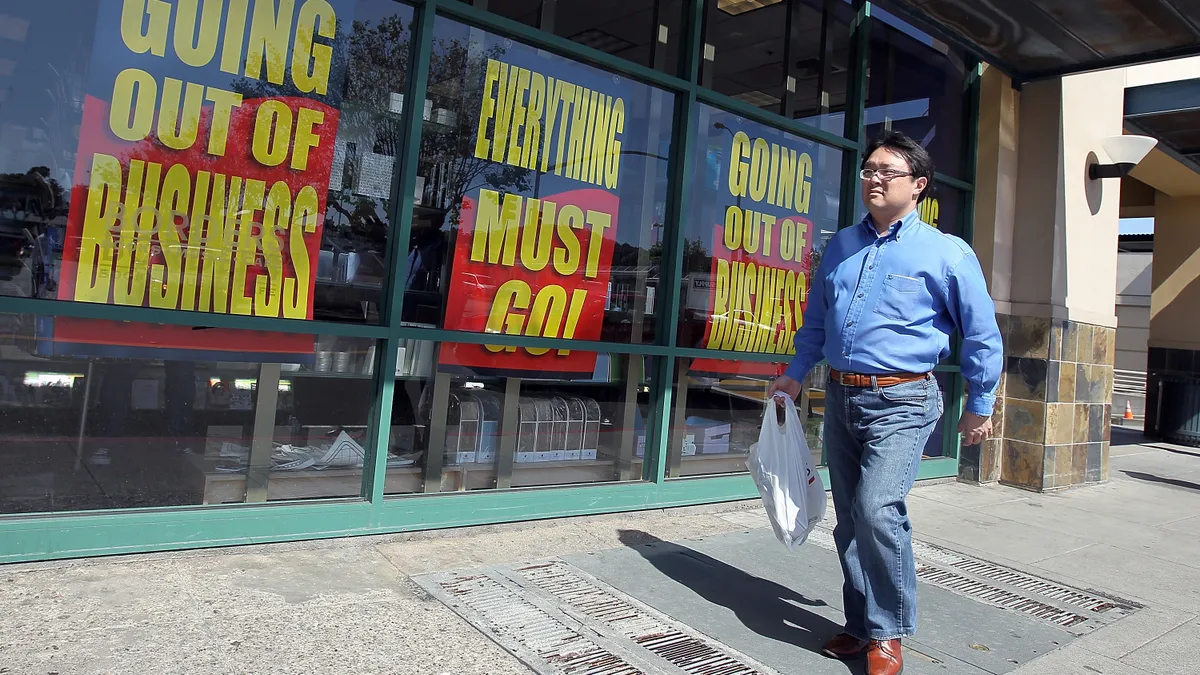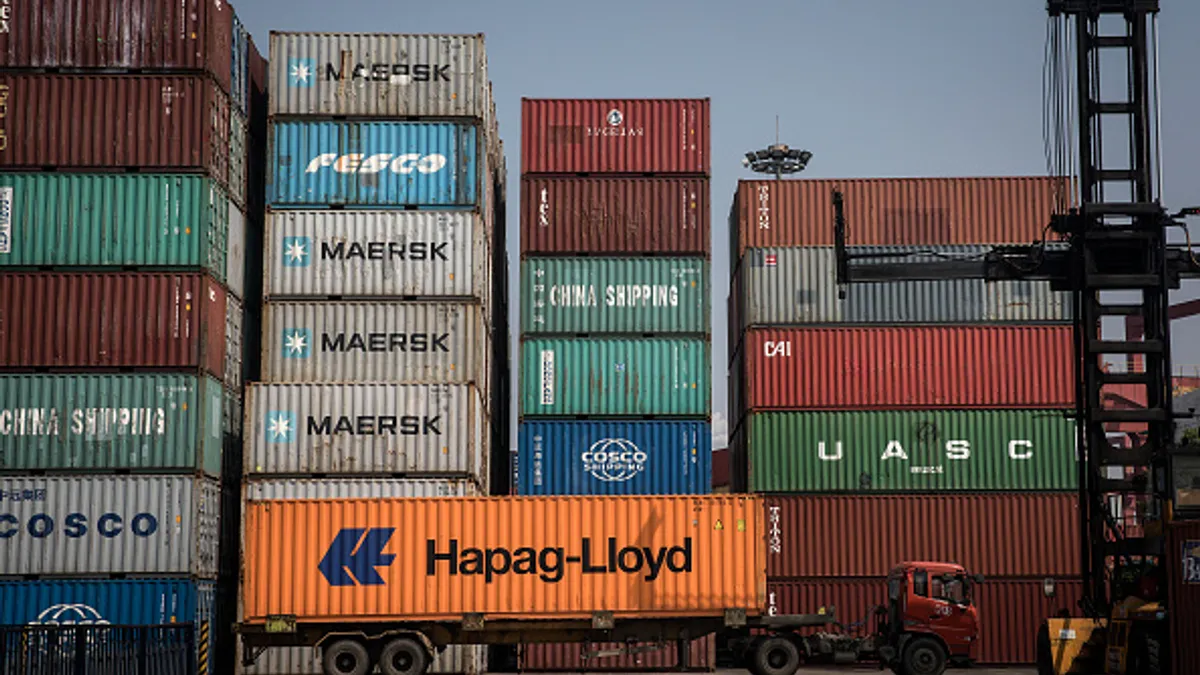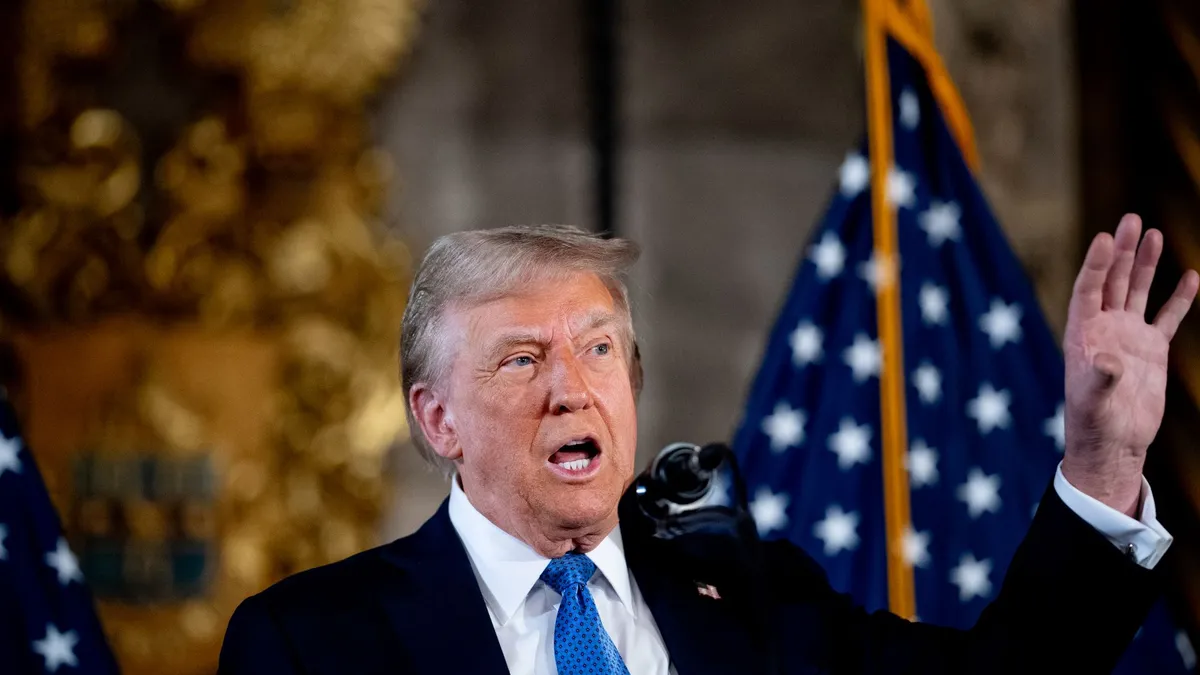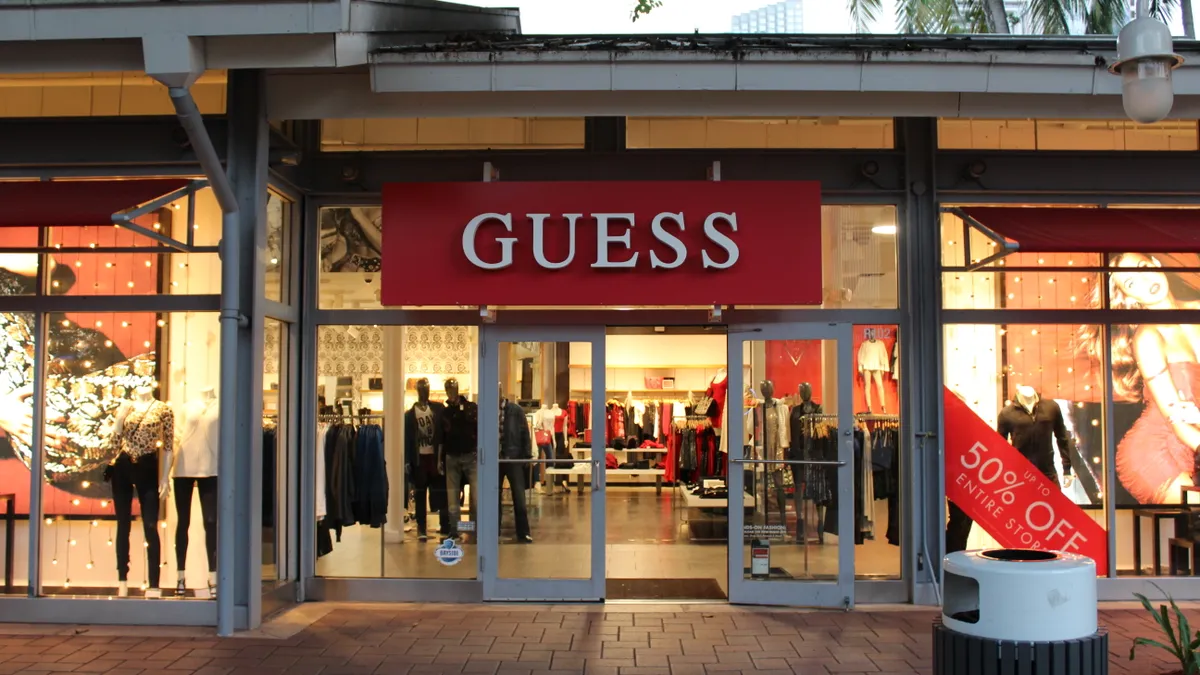Four months in, 2016 has not been kind to retailers. Hamstrung by disappointing holiday season sales, unseasonably mild winter weather and the strong U.S. dollar, retailers suffered one of the most disappointing stretches in recent memory, culminating in a series of Chapter 11 bankruptcy filings.
Sports Authority, Pacific Sunwear and Sport Chalet all filed for Chapter 11 protection in recent weeks, and the carnage doesn’t look to end anytime soon: At least one expert believes struggling athletic shoe retailer Finish Line could follow suit, and Aeropostale is reportedly considering a restructuring or sale as well.
Chapter 11 bankruptcy allows embattled businesses a limited period of time to restructure their finances and maximize returns to creditors and investors. Hundreds of major corporations have filed for Chapter 11 over the years: Some, like General Motors and United Airlines, survived the process, while others like Lehman Brothers did not.
The retail sector presents particularly compelling evidence that Chapter 11 does not necessarily sound the death knell. Here are seven retail brands that rebounded after filing for bankruptcy.
1. American Apparel
Founded: 1989
Filed for bankruptcy: 2015
Whether celebrated for its progressive labor practices or criticized for its provocative, racy advertising, American Apparel rarely strays far from the headlines, and its Oct. 5, 2015 Chapter 11 bankruptcy protection filing was no exception. Hobbled by the weight of millions of dollars of debt, sluggish sales, mounting competition from fast-fashion outlets and costly litigation against controversial founder Dov Charney—who was forced out as CEO following allegations of sexual misconduct and financial mismanagement—American Apparel fended off bankruptcy for months through a series of cash infusions before finally succumbing to the inevitable.
American Apparel’s creditors agreed to provide $70 million in new capital, as well as a $90 million bankruptcy loan to keep the company afloat. American Apparel in turn pledged to keep its remaining U.S. stores open for business as court proceedings unfolded. The company, renowned for sourcing materials and manufacturing products within American borders, also continued operations at its Los Angeles-area factories.
American Apparel emerged from Chapter 11 in February 2016, becoming a private company. Now known as American Apparel LLC, the retailer celebrated its rebirth by rolling out a new marketing campaign promoting a line of $30 "luxury" t-shirts. Once synonymous with over-the-top advertising efforts, American Apparel budgeted the campaign at a modest $500,000 after spending virtually nothing on marketing in 2015. Its future is still in doubt, however: In April 2016, American Apparel laid off about 500 employees, a move CEO Paula Schneider called part of a "redesign of our production process" that will see the company cut down on inventory to avoid discounts.
2. Circuit City
Founded: 1949
Filed for bankruptcy: 2008
Electronics retailer Circuit City, which at one time operated 1,520 stores across the U.S. and Canada, filed Chapter 11 bankruptcy in late 2008. Felled by declining consumer spending on electronics and out-of-date stores in unenviable locations, Circuit City was trading well below $1 per share at the time of the filing, which revealed its assets totaled $3.4 billion against debt of $2.32 billion, including a $119 million debt to Hewlett-Packard and a $116 million debt to Samsung Electronics.
Despite promises that Circuit City’s stores would stay open, no bidder stepped forward to rescue the company, and it was forced to convert its Chapter 11 bankruptcy to Chapter 7, ceasing all operations on March 8, 2009. Two months later, computer hardware retailer Systemax acquired Circuit City’s assets at auction for $14 million, relaunching the CircuitCity.com site on May 22. Less than six months later, Systemax consolidated its Circuit City and CompUSA brands under the TigerDirect brand and website.
Retail veteran Ronny Shmoel acquired Circuit City’s brand, domains and associated trademarks from Systemax last October. Terms were not disclosed. Reports say Shmoel and business partner Albert Liniado plan to open between 50 and 100 new Circuit City stores this year, as well as a new e-commerce site.
3. Eddie Bauer
Founded: 1920
Filed for bankruptcy: 2003 and 2009
Eddie Bauer regularly touts the durability of its outdoor apparel, and the company itself has proven resilient as well, surviving two trips to bankruptcy court. Then-parent Spiegel Inc. sought Chapter 11 protection in 2003 after eroding sales and credit card defaults led to debts of $1.7 billion. The company eventually sold its signature Spiegel direct marketing catalog and other assets, except for Eddie Bauer. In May 2005, Spiegel emerged from bankruptcy under the name Eddie Bauer Holdings, a reorganization that renowned U.S. bankruptcy Judge Burton Lifland called “almost a perfect poster child of what Chapter 11 is designed to be."
But Eddie Bauer Holdings itself filed for Chapter 11 bankruptcy in June 2009. Then-CEO Neil Fiske blamed its "crushing" debt burden: In order to emerge from the Spiegel bankruptcy, the company assumed $300 million in debt along with Spiegel’s pension and retirement benefits. Eddie Bauer Holdings also suffered as the recession curtailed consumer spending. Private equity firm Golden Gate Capital ultimately acquired the company at auction for $286 million.
Eddie Bauer now operates close to 375 stores across the U.S. and Canada, as well as online and wholesale businesses. However, its saga took still more twists and turns in early 2014, when men’s retailer Jos. A. Bank agreed to buy Eddie Bauer from Golden Gate Capital for approximately $825 million in cash and stock—a deal experts said would help Jos. A. Bank fend off a buyout from rival Men’s Wearhouse. But weeks later Jos A. Bank accepted Men’s Wearhouse’s $1.8 billion offer, scuttling the Eddie Bauer deal in the process. Jos. A. Bank was forced to pay Golden Gate a $48 million break-up fee.
4. Linens 'n Things
Founded: 1975
Filed for bankruptcy: 2008
Linens ‘n Things has changed hands more times in the last decade than some people have changed their bed sheets. At its peak, it was one of the North American market’s largest specialty retailers of home textiles, housewares and home accessories, but Linens ‘n Things’ sales slumped in the face of steep declines in the U.S. housing market and more cautious discretionary spending. In late 2005, the company accepted a $1.3 billion buyout offer from private equity firm Apollo Management, which opted to take the chain private.
The Apollo deal left Linens ‘n Things with substantial debt, and it filed for Chapter 11 protection on May 2, 2008, announcing its intent to close about a third of its 589 stores. In August 2008, the company proposed plans to emerge from bankruptcy by reverting to the “everyday low price” approach that vaulted Linens ‘n Things to prominence during its years as a public company, also improving the quality of its merchandise and promising greater attention to store inventory levels. But attempts to find a buyer failed, and in October of that year, the merchant asked for permission to auction its remaining 371 stores and begin going-out-of-business sales.
Linens ‘n Things returned from the grave in May 2009, three months after the newly-formed LNT Acquisition—a joint venture between liquidators Hilco Consumer Capital, Gordon Brothers Brands and Infinity Lifestyle Brands—purchased its brand name, website, mailing list and proprietary brands for $1 million. This incarnation operated solely on the web, favoring products and prices similar to those from its brick-and-mortar heyday. LNT Acquisition sold Linens ‘n Things for an undisclosed amount to Galaxy Brand Holdings in late 2013; it continues doing business online, and has not returned to physical retail.
5. RadioShack
Founded: 1921
Filed for bankruptcy: 2015
RadioShack, a brand once synonymous with do-it-yourself electronics retail, hit the skids as rivals like Apple and Amazon redefined the market, transforming consumer behaviors, interests and expectations. Following years of declining sales, failed strategic shifts and management issues, RadioShack filed for Chapter 11 protection on Feb. 3, 2015 and targeted close to 1,800 stores for closure, prompting late night host Jimmy Kimmel to crack, “People just aren't buying as many blank VHS tapes as they used to.”
On March 31, 2015, a bankruptcy judge approved the $160 million sale of 1,740-plus RadioShack stores to hedge fund Standard General, saying its offer was “economically superior” to another led by investor Salus Capital and that it preserved stores and jobs rather than liquidating a “century-old American retailing icon.” Per terms of the agreement, Standard General partnered with wireless carrier Sprint to establish Sprint-branded stores-within-stores inside RadioShack locations, with RadioShack collecting commissions on Sprint products and services.
The reborn RadioShack has attempted to repair its unhip image and attract younger consumers by launching a social media marketing campaign featuring comedians Orlando Jones and Carlos Mencia, as well as endorsements and product offers posted to Twitter and Facebook. The company also partnered with hip-hop legend Robert Diggs (better known as Wu-Tang Clan founder RZA) to sell exclusive merchandise. RadioShack’s future remains murky, however: After just nine months on the job, CEO Ron Garriques stepped down in early 2016 “to pursue other interests.”
6. The Sharper Image
Founded: 1977
Filed for bankruptcy: 2008
As the 20th century wound to its close, shoppers coveting beverage-dispensing cushions, robotic bathroom scales, battery-powered sports cars for children and other quintessential examples of American excess needed look no further than the Sharper Image. Its aspirational retail stores and monthly print catalog perfectly encapsulated the high-tech, high-priced consumer lifestyle of the 1980s and 1990s, proving the mainstream viability of seemingly ludicrous products like $5,000 massage chairs on its way to becoming a $760 million public company with close to 200 stores nationwide.
But the Sharper Image’s future grew fuzzy on Feb. 19, 2008, when the company filed for Chapter 11 bankruptcy. Beyond the declines in consumer spending that undermined many retailers entering the new millennium, the Sharper Image also suffered from disastrous publicity that dogged its once-popular Ionic Breeze Quadra air purifier. The Sharper Image sued Consumer Reports magazine over a 2002 investigation into fan-driven air purifiers like the Quadra, claiming its testing protocols were scientifically invalid; the suit was later dismissed. Threw years later, Consumer Reports revealed that the Quadra produced trace levels of ozone that could pose dangers to consumers’ health. Sales tanked, and Sharper Image stores agreed to give out cash refunds on many Quadra units, even some sold years earlier.
Private equity firm Camelot Venture Group acquired the rights to the Sharper Image for an unspecified sum in August 2009, relaunching the print catalog and website the following year. Iconix Brand Group snapped up the Sharper Image brand in 2011 for approximately $65.6 million in cash, with Camelot continuing to own and operate print and online sales efforts.
7. Wet Seal
Founded: 1962
Filed for bankruptcy: 2015
The sun set on West Coast-themed young women's apparel retailer Wet Seal on Jan. 15, 2015. Battered by declining mall traffic and fierce competition from fast-fashion rivals like Forever 21, H&M and Zara, the company filed for Chapter 11 protection after losing more than $150 million over the previous two years and defaulting on $27 million in senior convertible notes. In the weeks leading up to the filing, Wet Seal shuttered 338 stores without warning, driving some employees to post angry signs in vacant store windows decrying management’s handling of the situation.
Private equity firm Versa Capital Management acquired Wet Seal on April 1, 2015. The new company, known as The Wet Seal, LLC, continued operating its 173 surviving stores and developing its online commerce efforts, buoyed by a new $15 million senior credit facility provided by Versa affiliate Crystal Financial. Versa also appointed former Wet Seal executive Melanie Cox as the retailer’s new CEO, its fourth chief executive in as many years.
Cox is returning Wet Seal’s apparel to its laid-back, Southern California roots: “So many of the cues that these girls are getting are from celebrities, musicians, bloggers," she recently told Racked. "They're photographed by the paparazzi all over the place, and a lot of times, that's in L.A."
The resuscitated Wet Seal also boasts a new website and new logo, with a mobile app in the pipeline, and it’s growing its plus-size business. Wet Seal’s comeback is far from complete, but its progress serves notice to Pacific Sunwear and other struggling teen retailers that Chapter 11 isn’t necessarily the final chapter.






















